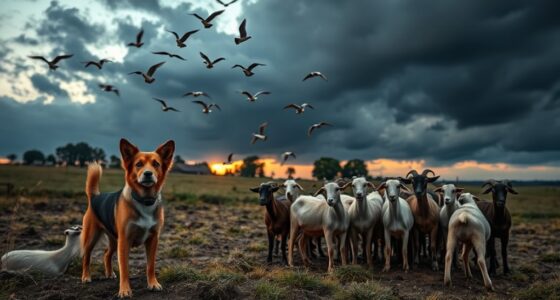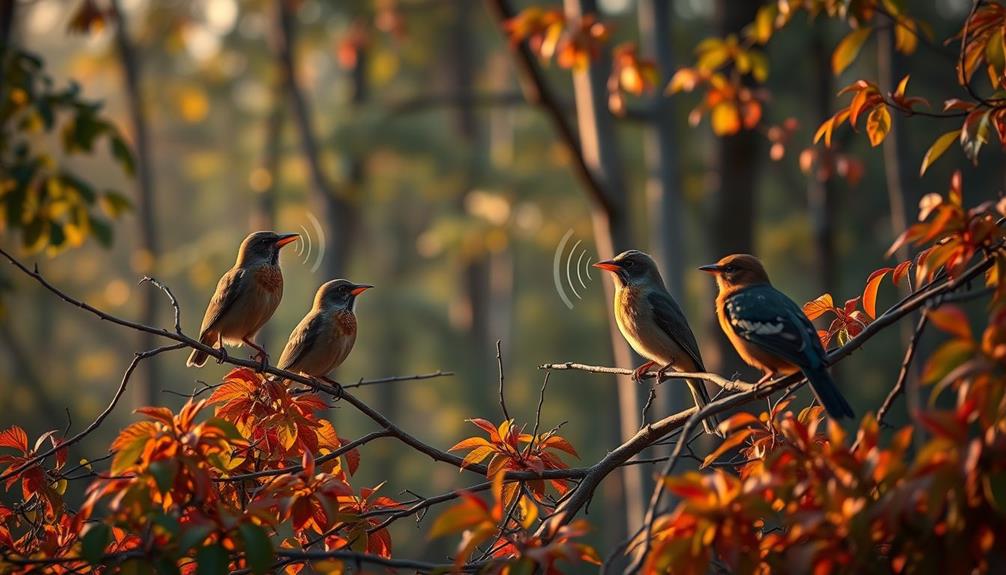Animals sense the seasons by picking up on environmental cues like temperature changes, daylight duration, and food availability. These signals trigger significant adaptations, such as changes in behavior, physiological processes, and migration patterns. For example, birds rely on the sun's position and stars to navigate while hibernators alter their body temperature and metabolism. These adaptations are essential for survival. There's much more to discover about how animals adapt to seasonal changes and the impact of climate change on these behaviors.
Key Takeaways
- Animals use changes in temperature and daylight duration to regulate reproductive cycles and behaviors, known as photoperiodism.
- Migratory birds navigate seasonal changes by detecting the sun's angle and the position of stars.
- Hormonal fluctuations triggered by environmental cues influence breeding, foraging, and preparation for hibernation or migration.
- Circadian rhythms, aligned with seasonal changes, help animals time migrations and other critical behaviors.
- Seasonal coat changes in animals, such as fur color, enhance camouflage and warmth, signaling adaptations to environmental shifts.
The Role of Environmental Cues in Seasonal Changes

As the seasons shift, animals rely on key environmental cues to adapt their behaviors and survival strategies. Changes in temperature, daylight duration, and food availability are vital signals that guide animal behaviour throughout the year.
For many species, photoperiodism—the response to the length of day and night—regulates reproductive cycles and essential behaviors. Migratory birds, for instance, navigate using the sun's angle and stars, ensuring they reach their destinations for breeding or feeding.
Additionally, temperature fluctuations trigger hibernators to enter or exit dormancy, preparing them for seasonal challenges. When food resources and habitat conditions change, the timing of breeding, foraging, and migration also shifts, demonstrating how deeply connected animal behaviour is to these environmental cues.
Physiological Adaptations to Seasonal Shifts

Environmental cues not only influence animal behavior but also drive significant physiological adaptations that help them cope with seasonal changes.
Environmental cues shape not just behavior but also vital physiological adaptations that enable animals to survive seasonal shifts.
Here are some key adaptations:
- Fur Changes: Mammals like snow hares and ermines alter their fur structure and color, enhancing camouflage and warmth during winter.
- Hibernation: Bears and ground squirrels reduce body temperature and metabolism, conserving energy through harsh winters.
- Migration Mechanisms: Migratory birds develop specialized systems to detect changes in daylight and temperature, prompting them to seek more favorable areas.
- Hormonal Fluctuations: Seasonal shifts trigger hormonal changes that influence breeding, foraging, and preparation for hibernation or migration.
Understanding these adaptations is essential for wildlife conservation and appreciating how animals thrive in their environments.
Behavioral Responses to Changing Seasons

When seasons change, animals instinctively adjust their behaviors to survive the shifting environment. For instance, the snow hare and ermine adapt by changing their fur color from brown in summer to white in winter, providing essential camouflage against predators.
Hibernators like bears and ground squirrels lower their body temperature and metabolism to conserve energy during harsh winters.
Meanwhile, migratory birds travel vast distances to find ideal breeding conditions, reacting to environmental cues and weather patterns. This timing is vital; it directly impacts their survival and reproduction, as it aligns with seasonal changes in food availability.
These behavioral adaptations—camouflage, hibernation, and migration—show the intricate connections between animals and their environments, ensuring their survival through seasonal shifts.
The Importance of Circadian Rhythms

Circadian rhythms play an essential role in how animals navigate their daily lives, regulating fundamental functions like sleep, hormone release, and feeding patterns.
These internal clocks typically follow a 24-hour cycle and are influenced by environmental cues, especially light.
Here's why they're critical:
- Synchronization: They help animals align their behaviors with seasonal changes.
- Health: Disruption of these rhythms can negatively affect behavior, reproduction, and overall health.
- Migration: Animals use circadian rhythms to time migrations, ensuring they're in the right place at the right time.
- Adaptation: By responding to light signals, animals can adapt their activities to the changing seasons.
Understanding these rhythms reveals how intricately connected animals are to their environments.
Hibernation: A Strategy for Survival

As temperatures drop and daylight wanes, many animals turn to hibernation as an essential strategy for survival. This adaptation, seen in bears and ground squirrels, allows them to endure harsh winter conditions by considerably lowering their body temperature and metabolism.
During hibernation, you'll find these animals in a state of torpor, where their heart rate and breathing slow down, conserving energy for months without needing food. Environmental cues like decreasing temperatures signal them to prepare for winter.
Some hibernators briefly wake to eat stored fat, while others stay in deep sleep until spring. This remarkable strategy not only helps them survive but also aligns with their reproductive cycles, ensuring they emerge when food is more plentiful.
Seasonal Coat Changes in Mammals

As seasons shift, you might notice how some mammals change their coats to adapt to the weather.
For instance, animals like the snow hare transform from brown to white, blending into their snowy surroundings for better camouflage against predators.
These seasonal fur changes not only help them stay warm but also play an essential role in their survival.
Summer vs. Winter Fur
When the temperatures shift with the changing seasons, many mammals respond by altering their fur, preparing for the demands of summer and winter. This seasonal coat change is essential for their survival.
Here's how it works:
- Color Change: Species like the snow hare shift from brown in summer to white in winter for camouflage.
- Fur Density: Mammals grow thicker fur in winter to trap heat and provide insulation.
- Texture Variation: The texture of winter fur becomes coarser, enhancing warmth.
- Hormonal Triggers: Changes in temperature and daylight length trigger hormonal adjustments that initiate these transformations.
Camouflage and Predation
Seasonal coat changes in mammals aren't just about warmth; they're an essential strategy for survival in the wild. Many mammals, like the snow hare and ermine, adapt their fur color to blend in with their environment, enhancing their camouflage against predators. This clever adaptation not only protects them but also aids in hunting, making them less visible to their prey.
| Mammal | Summer Coat Color | Winter Coat Color |
|---|---|---|
| Snow Hare | Brown | White |
| Ermine | Brown | White |
| Arctic Fox | Brown | White |
The Migration Patterns of Birds

Birds commence on remarkable migrations each year, traversing vast distances between their breeding and wintering grounds. These journeys are fascinating and vital for their survival.
Here are some key points about bird migration patterns:
- Many species, like the Arctic Tern, travel up to 44,000 miles annually.
- Environmental cues such as temperature changes, daylight length, and food availability guide their timing.
- Some birds, like the Swallow, exhibit strong site fidelity, returning to the same nesting sites each year.
- Weather conditions, including storms, can affect migration timing and success, making adaptability significant.
Understanding these patterns helps you appreciate the resilience and navigational skills of these incredible creatures.
Camouflage and Predation in Different Seasons

As the seasons shift, many animals adapt their appearance to blend seamlessly into their surroundings, enhancing their chances of survival.
Take the snow hare and ermine, for instance; they change their fur from brown in summer to white in winter, providing effective camouflage against snow-covered landscapes. This color change, triggered by shifts in daylight and temperature, not only helps them evade predators but also boosts their hunting success by allowing them to sneak up on prey.
The Arctic fox takes it a step further, altering both fur texture and color for better insulation against the cold.
Such camouflage strategies are essential, maintaining the delicate balance between predator and prey throughout the year, ensuring survival in nature's ever-changing environment.
Energy Conservation Techniques in Wildlife

When harsh winter conditions arrive, many wildlife species implement energy conservation techniques to survive the challenges posed by food scarcity and extreme weather.
You might observe these fascinating strategies:
- Hibernation: Bears and ground squirrels enter torpor, lowering their body temperature and metabolic rate to save energy.
- Camouflage Adaptation: Snowshoe hares change fur color, enhancing camouflage and reducing predation risk while foraging.
- Fat Storage: Migratory birds build fat reserves before migration, enabling them to travel long distances without constant feeding.
- Reduced Activity: Arctic ground squirrels enter deep hibernation for months, considerably cutting their energy demands.
These adaptations highlight how wildlife cleverly manages energy resources, ensuring their survival during winter's harshest challenges.
The Impact of Climate Change on Seasonal Behaviors

Seasonal behaviors in wildlife are increasingly influenced by climate change, shifting the delicate balance that many species rely on for survival. For instance, migratory birds are arriving at breeding grounds earlier due to warmer temperatures, while hibernators emerge weeks sooner than before. This misalignment affects not just individual species, but entire ecosystems, leading to significant consequences.
| Affected Species | Impact |
|---|---|
| Migratory Birds | Arrive earlier, risking food shortages |
| Hibernators | Emerge too soon, disrupting predator-prey relationships |
| Snow Hares | Mismatched fur colors, reducing camouflage |
These changes can cascade through ecosystems, affecting biodiversity and the delicate interactions between species. Adaptation becomes essential for survival in this rapidly changing environment.
Frequently Asked Questions
How Do Animals Know the Season?
You might wonder how animals know the season. They rely on environmental cues like daylight length and temperature changes.
These signals trigger biological responses, helping them adapt. For instance, their specialized cells detect light variations, prompting behaviors like migration or reproduction.
Hormonal shifts influenced by these cues also play a role in fur molting or breeding cycles, ensuring they align with the best conditions for survival and reproduction.
How Do Animals Know What Season It Is?
Did you know that over 80% of migratory birds rely on the length of daylight to determine when to migrate?
Animals know what season it's through various environmental cues. You'll find that changes in temperature, daylight, and food availability trigger their instincts.
For instance, birds might start singing as days get longer, while hibernators prepare for winter by sensing hormonal shifts.
These adaptations are essential for their survival and reproductive success.
How Do Animals Sense Weather Changes?
Animals sense weather changes through various environmental cues.
You'll notice that fluctuations in temperature, light, and humidity trigger different behaviors in animals. For instance, migratory birds respond to changes in day length to prepare for their journeys.
Similarly, mammals like snow hares detect shifts in temperature, prompting them to change their coats.
How Do Animals Know When It's Mating Season?
Did you know that over 90% of bird species rely on changes in day length to time their mating seasons?
Animals know it's mating season primarily through environmental cues. You see, they detect changes in photoperiod and temperature, which trigger hormonal shifts.
Additionally, some species use pheromones to signal readiness. Observing behaviors like increased vocalizations or physical changes, such as antler growth in deer, also indicates that it's time to mate.
Conclusion
In summary, animals have an incredible ability to sense and adapt to the changing seasons, using environmental cues, physiological changes, and behavioral strategies. From hibernating like furry little time capsules to migrating thousands of miles, these adaptations showcase nature's brilliance. As climate change disrupts these patterns, the delicate balance of ecosystems hangs by a thread. It's essential that we comprehend and protect these remarkable creatures; after all, they're the heartbeat of our planet's seasonal symphony.










